Backhaul blues and a gradual decline in liner schedule reliability
Liner schedule reliability data continues to show the Gemini Cooperation achieving the highest on-time vessel ...

The Panama Canal could be back at nearly full capacity in time for this year’s peak season, if current rainfall forecasts prove to be accurate.
The Panama Canal Authority (ACP) yesterday released a new schedule for the number of daily transits it expects to be able to handle over the coming months.
The canal has a design capacity of 36 transits a day, although this is typically expressed as 34 to 38, but is currently allowing just 27.
There were fears last year, ...
Asia-USEC shippers to lose 42% capacity in a surge of blanked sailings
USTR fees will lead to 'complete destabilisation' of container shipping alliances
New USTR port fees threaten shipping and global supply chains, says Cosco
Outlook for container shipping 'more uncertain now than at the onset of Covid'
Transpac container service closures mount
DHL Express suspends non-de minimis B2C parcels to US consumers
Zim ordered to pay Samsung $3.7m for 'wrongful' D&D charges
Flexport lawsuit an 'undifferentiated mass of gibberish', claims Freightmate

Comment on this article